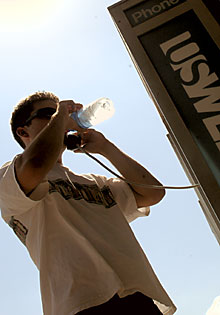 |
|
Joshua Sills\ Arizona Summer Wildcat
|
On a July day with temperatures above 100 degrees Andrew Herndon, a regional development senior refreshes himself with a cold bottle of water. To be properly hydrated one should drink six to eight, eight to 10 ounce glasses of non-caffeinated beverages a day.
|
|
By James Kelley
Arizona Summer Wildcat
Wednesday July 23, 2003
Proper hydration a must in Tucson weather
Tucson's sunny dry heat and monsoon storms mean students new to the area may need to know how to get hydrated and be wary of lightning and strong winds.
To get hydrated, you should drink six to eight, 8-10 onces non-caffeinated drink, that don't necessarily have to be water, said Lisette LeCorgne, a nurse practitioner for Campus Health Services.
"Particularly if you are from areas of high humidity, the most important thing is to drink when you are not thirsty," LeCorgne said.
You should urinate a lot and the urine should be clear or light yellow, not dark, LeCorgne said.
Someone that is properly hydrated should urinate at least two to three times a day, she said.
Headaches and lack of urination signal the start of dehydration, which could lead to nausea and vomiting, LeCorgne said.
"If you have any of those symptoms, go to Campus Health, or if it is on the weekend, it is reason to go to Urgent Care," LeCorgne said.
Dehydration can also lead to eye irritation, and women are more likely to get urinarytract infections.
LeCorgne sees probably 10 to 15 cases of dehydration each year, but recently it has been getting better, perhaps because people are more aware, she said.
"The horror stories are when people don't catch it soon enough," LeCorgne said.
In addition to the heat, the fall semester also starts during Tucson's monsoon season, which is characterized by thunderstorms and strong winds.
Steven Mullen, director of the UA's institute of atmospheric physics, said students need to understand lightning, the biggest weather-related killer in the U.S.
Mullen said students can measure the distance of lightning by counting the number of seconds between when the lightning strikes and when they hear the thunder. Every five-second interval equals one mile, and if the storm is within five miles, students should take cover, Mullen said.
"The second thing you need to know about thunderstorms is (that) very strong winds accompany them," said Mullen, who is also head of the atmospheric sciences department and a hydrology & water resources and atmospheric sciences professor. "All kinds of things that you don't want are flying around like the roofs of car sheds."
Washes, or usually-dry riverbeds, can flood very quickly. The state of Arizona has a law named the "Stupid Motorist Law," which states that when a motorist drives into a flooded area, becomes trapped and must be rescued, the driver must pay for the expense of the rescue.
As soon as the monsoon season ends, the nighttime temperature will cool down a lot because there is less humidity, but the daytime temperature will drop more slowly, said Mullen
The hottest part of the year, late June, has already passed. January is the coldest month in Tucson, with an average low of 37 and an average high of 65, Mullen said.
To combat the seemingly ever-present sun, LeCorgne recommended that students wear sunscreen of SPF 30 to 45 on the areas most at risk: the ears, top of the nose and shoulders.
"The lowest number of sunscreen recommended is 15," LeCorgne said. "The effects of the sun culminate over a lifetime."
The worst hours to be outside are from noon to 3 p.m., she added.
The Sonoran Desert's weather is unique to the rest of the country because of wide differences between daytime highs and nighttime lows. The rain that does fall in Tucson generally fall half in the summer and half in the winter, Mullen said.
"Most places have a distinct wet season," Mullen said.

